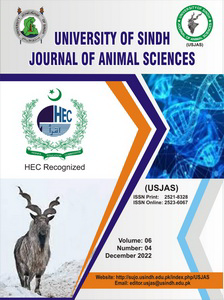Field and Laboratory Studies on the Toxicity of Lambda-Cyhalothrin for Controlling Desert Locust (Schistocerca Gregaria)
Abstract
Desert locust has negative impact on world vegetation, severely affected Africa and Asia in 2020-21. The pest persists in both gregarious and solitary forms. In Pakistan, the majority of the nation experienced a desert locust attack in 2020. Seven to ten districts in Khyber Pakhtunkhwa were seriously impacted. The study was carried out to test the efficacy of different concentrations of Lambda-cyhalothrin 2.5 EC against adult and hoppers/nymph in field and laboratory conditions. The applied concentration was 4%,3%, 2%, 1% and 0.5 % for adults in field and lab conditions, while 2%, 1.5%, 1%, 0.5% and 0.25% for nymph’s trials. Under field condition against adults all the applied concentrations were at par with each other except 0.5%, which showed significantly lower mortality rate (60%). A similar trend of toxicity was also recorded for the laboratory trials. More than 85% mortality was recorded in all treatment except 0.5%, which was 65%. Against hopper all concentration showed significant higher mortality (above 80%) except the nymphs sprayed with 0.25% concentration under field conditions. Similar results were also obtained for vitro trials against nymphal stage. It is concluded an average concentration (3%) should be applied for adult to avoid resistance and pest escape. For hoppers/nymph the recommended concentration should be 1%. Further studies should be carried out regarding the resistance to different types of insecticides under field and laboratory conditions.
papers are accepted on the understanding that the work has been submitted exclusively to the journal and has not been previously published. Authors will be supplied with copyright form, which must be completed and returned to the publisher. Papers will not be published until the signed copyright disclaimer has been received.
Kindly download the copyright for below and attach as a supplimentry file during article submission










